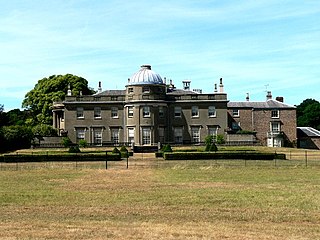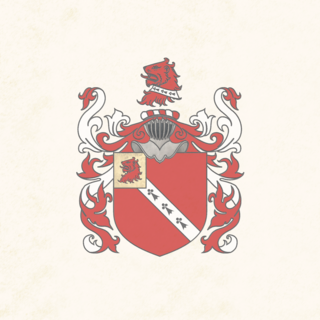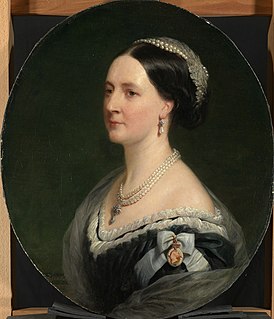
Viscount Eccles, of Chute in the County of Wiltshire, England, is a title in the Peerage of the United Kingdom. It was created on 14 January 1964 for the Conservative politician David Eccles, 1st Baron Eccles. He had already been created Baron Eccles, of Chute in the County of Wiltshire, on 1 August 1962. As of 2017 the titles are held by his son, the second Viscount, who succeeded in 1999. He is one of the ninety elected hereditary peers that remain in the House of Lords after the passing of the House of Lords Act 1999, and sits as a Conservative. His wife Diana Eccles was created a life peer as Baroness Eccles of Moulton, of Moulton in the County of North Yorkshire, on 10 May 1990, making the couple an unusual husband and wife pair both sitting in the House of Lords. Lady Eccles of Moulton also sits on the Conservative benches.

The House of Percy is an English noble family. They were one of the most powerful noble families in Northern England for much of the Middle Ages, known for their long rivalry with another powerful northern English family, the House of Neville.

Scampston Hall is a Grade II* listed country house in North Yorkshire, England, with a serpentine park designed by Charles Bridgeman and Capability Brown. It is located on the north side of the A64 Leeds/Scarborough road, 4 miles (6 km) east of Malton, in Scampston village. The name of the village was referred to in various ways in ancient documents as: Scamestun, Skameston, Skameston, and Skampston, and was probably derived from a personal name.

Stanwick St John is a village, civil parish, former manor and ecclesiastical parish in the Richmondshire district of North Yorkshire,, England. It is situated between the towns of Darlington and Richmond, close to Scotch Corner and the remains of the Roman fort and bridge at Piercebridge.

Hovingham Hall is a country house built in the Palladian style in the village of Hovingham, North Yorkshire, England. It has been the seat of the Worsley family and the childhood home of the Duchess of Kent. It was built in the 18th century on a site the Worsleys have occupied since the 16th century.
Sir William Marcus John Worsley, 5th Baronet, was a British Conservative Party politician. He served as a Member of Parliament in four parliaments between 1959 and 1974, and served as High Sheriff and Lord Lieutenant for North Yorkshire.

Marske Hall is a 17th-century former mansion house, now a Valorum Care Group residential care home, in Marske-by-the-Sea, Redcar and Cleveland, England. It has Grade I listed building status.

Moulton is a small village and civil parish in the Richmondshire district of North Yorkshire, England. It lies in a secluded valley between the villages of Scorton and Middleton Tyas.

The Smithson Baronetcy, of Stanwick in the County of York, is a title in the Baronetage of England. It was created on 2 August 1660 for Hugh Smithson (1598-1670) of Stanwick St John, Yorkshire. Sir Hugh Smithson, the fourth Baronet, married Lady Elizabeth Seymour, daughter of Algernon Seymour, 7th Duke of Somerset and heiress of the Percy family headed by the Earl of Northumberland. In 1749 the Duke was created Earl of Northumberland, with remainder to his son-in-law Sir Hugh Smithson, who succeeded as second Earl on his father-in-law's death in 1750. He assumed the surname of Percy and was created Duke of Northumberland in 1766. The baronetcy remains merged with the dukedom.

Close House is a country estate near Heddon-on-the-Wall, Northumberland. The estate contains a Grade II* listed former mansion house, which is currently a private residence, and Close House Golf Club.

The Milbanke, later Noel, later Milbanke Baronetcy, of Halnaby in the County of York, was a title in the Baronetage of England. It was created on 7 August 1661 for Mark Milbanke. His father was Mark Milbanke of Chirton, Northumberland a Newcastle on Tyne merchant and hostman who was Sheriff of the city in 1638, and Mayor in 1658 and 1672, and whose marriage brought him an estate at Halnaby, near Darlington, North Yorkshire. The second Baronet was High Sheriff of Northumberland in 1678. The third Baronet was High Sheriff of Northumberland 1685 and Member of Parliament for Richmond. The fifth Baronet was Member of Parliament for Scarborough and Richmond. The sixth Baronet sat as Member of Parliament for County Durham. He married Judith Noel and changed his surname in 1815, but he died leaving only a daughter, Annabella, who married the poet Lord Byron, and so he was succeeded by his nephew. The tenth Baronet was awarded the Victoria Cross. The title became extinct on the death of the twelfth Baronet in 1949.

Middleton Lodge is a Georgian Palladian mansion set within 200 acres (0.81 km2) of open countryside, on the outskirts of the village of Middleton Tyas, a mile or so off the A1 near Scotch Corner and a 15-minute drive from Darlington, County Durham.
Sir Charles Le Grosse was an English politician who sat in the House of Commons at various times between 1628 and 1653.

Thirkleby Hall was a large 18th-century country house in Great Thirkleby in the Hambleton hills of North Yorkshire. It was demolished in 1927.

Fairfax House is a Georgian townhouse located at No. 27, Castlegate, York, England, near Clifford's Tower and York Castle Museum. It was probably built in the early 1740s for a local merchant and in 1759 it was purchased by Charles Gregory Fairfax, 9th Viscount Fairfax of Emley, who arranged for the interior to be remodelled by John Carr (architect). After the Viscount's death in 1772, the house was sold and subsequently passed through a number of local families before spending some time as a Gentleman's Club, a Building Society and a cinema. The property was bought by York Civic Trust in the 1980s and completely restored to its former grandeur. Fairfax House is now a museum open to the public and a Grade I listed building.

Sir Hugh Smithson, 1st Baronet of Stanwick St John, North Yorkshire, was a Royalist supporter during the Civil War for which he was rewarded with a baronetcy by King Charles II on the Restoration of the Monarchy in 1660. His great-great-grandson was Sir Hugh Smithson, 4th Baronet (1715-1786), who having inherited by his marriage half of the great Percy, Earl of Northumberland, estates, and the title 2nd Earl of Northumberland by special remainder from his father-in-law Algernon Seymour, 7th Duke of Somerset (d.1750), changed his surname and arms to Percy and was created in 1766 1st Duke of Northumberland.
Susanna Dalbiac was a British woman, notable for participating in the Peninsular War alongside her husband.

Susanna Innes-Ker, Duchess of Roxburghe was a friend and Lady of the Bedchamber to Queen Victoria. Born into a military family, she married the 6th Duke of Roxburghe in 1836. Innes-Ker was one of Victoria's longest serving ladies-in-waiting, holding the appointment from 1865 until her death.

Sir Ralph Milbanke (1725-1798) was an English peer and Member of Parliament for Scarborough between 1754–61 and later for Richmond between 1761 and 1768.
Sir Ralph Noel, 6th Baronet was a British landowner and politician, and father-in-law of Lord Byron. Before 1815 he was known as Sir Ralph Milbanke.














